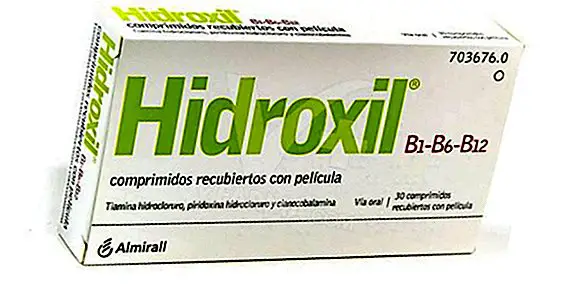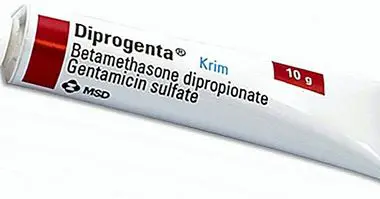Hydroxyl (B1-B6-B12): functions and side effects of this drug
Our body is a conglomerate of systems and organs integrated and organized in an effective and efficient way, its operation being what allows our survival and adaptation to the environment. For this operation is neither self-sufficient nor eternal, our body needs a large amount of oxygen and nutrients. Among the latter we can find various types of vitamins, essential for many body systems.
The absence of said vitamins , either by not integrating enough into our diet or product of some pathology, can have consequences of variable severity and in multiple body systems, such as weakness, appearance of inflammation or pain.
Fortunately we have different drugs and supplements that can help to try to supply a specific deficiency or increase the amounts of some vitamins present in the body that can have a beneficial effect on some ailment. This is the case of Hydroxil B1-B6-B12, which we are going to talk about below .
- Related article: "Types of medications (according to their use and side effects)"
What is Hydroxil B1-B6-B12?
It receives the name of Hidroxil B1-B6-B12 a medicine composed of different vitamins of group B and that is used mainly in states of deficiency of these vitamins or to certain problems linked to pain and inflammation of nerve pathways, being indicated for people over twelve years of age.
Specifically, this is a drug in the form of film-coated tablets that is mainly formed by vitamins B1, B6 and B12, also known as thiamin hydrochloride (B1), pyridoxine hydrochloride (B6) and cyanocobalamin (B12). This set of vitamins is associated with the metabolism of carbohydrates and proteins , being especially associated to that which occurs in the nervous and neuroendocrine system.
Thus, this drug has a modulating effect that can alter the functioning of various neurotransmitters in addition to promoting health and the transmission of information (also related to the synthesis of myelin covering neurons) of these systems. Likewise, their association has an influence on the transmission of information related to the perception of pain at both thalamic and spinal level, something that makes it have the property to mediate and reduce the level of pain of various conditions.
What is it for? Principal functions
Hydroxyl B1-B6-B12 is as we just mentioned a drug that has repercussions at the level of nerve pathways , being many of the main indications of this drug deeply linked to this system.
Primarily, it is considered that Hydroxil is especially indicated in those people who have some type of anemia with vitamin B group deficiency , in addition to those conditions in which there is a state of convalescence and weakness. Another possible indication is the presence of asthenia, usually related to the previous symptomatology, and fatigue.
It is also indicated for the pain of low back pain or sciatica, as well as the effects derived from neuritis and other neuropathies, given its effects on the modulation of pain and of different neurotransmitters.
Side effects and contraindications
Hydroxyl B1-B6-B12 is a compound formed mainly by vitamins of group B, something that can seem in principle something totally healthy and innocuous. However, an excess of these vitamins in our body It can be harmful and have severe side effects .
As secondary symptoms have been observed that the drug can cause dizziness and agitation, headaches, as well as conjunctivitis, tingling, drowsiness or insomnia, diarrhea or loss of appetite. It can generate changes in the coloration of urine, because its high content of vitamins can cause kidney or liver problems or alterations. Also photosensitivity with skin rashes, dermatitis may appear.
In some cases, purple thrombocytopenia has been observed (platelet deficiency in blood that makes coagulation difficult) or the appearance of rosacea fulminans, in addition to increasing the risk of getting gout. In the case of vitamin B6, excessive or very prolonged consumption can be toxic at the neuronal level, and may generate peripheral sensory neuropathy (a condition linked to the loss of sensitivity of the extremities and peripheral nerves).
It can also generate alterations in memory, autoimmune problems and effects on the visual system . It has also been linked to the appearance of rosacea fulminans, in addition to increasing the risk of gout and generating respiratory difficulties. In rare cases, a severe allergic reaction or a decrease in folic acid may occur.
Due to these side effects, Hydroxil has several conditions in which it is contraindicated. The first of them and perhaps the most obvious is the case of all those people who have allergy or hypersensitivity to any of its components. In addition, neither should those with kidney or liver problems, nor the population of less than twelve years of age.
It is totally contraindicated also in pregnancy and lactation , since it can alter the nervous function and proprioception of the fetus, generate dependence on it or even cut off breastfeeding. If any other medication is taken continuously, the physician should be consulted about the suitability of continuing to take this drug, due to the fact that it has numerous interactions with different groups of medicines. Joint use with alcohol or other drugs should also be avoided.
Bibliographic references:
- Vidal Vademecum Spain (2016). HIDROXIL B1-B6-B12 Comp. coated with a movie [On-line]. Available at: //www.vademecum.es/medicamento-hidroxil+b1-b6-b12_44109.



















